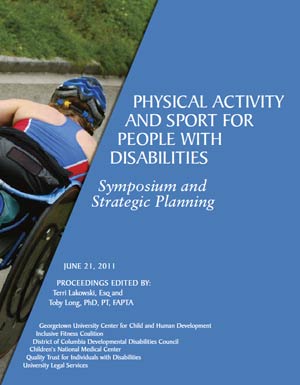Physical Activity and Sport for People with Disabilities
December 13, 2011

|
| Download |
|
|
Executive Summary
The Inclusive Fitness Coalition and the University Center for Excellence in Developmental Disabilities at Georgetown University hosted the Physical Activity and Sport for People with Disabilities Symposium and Strategic Planning Meeting on June 21-22, 2011. The symposium and strategic planning meeting brought together key stakeholders to create a community blueprint for action. Experts in the field of activity, fitness, sports, and athletics for people with disabilities collaborated with athletes with disabilities, service providers, and advocates to develop a strategic plan for how to expand physical activity, fitness, and sports for people with disabilities and advance the forthcoming policy recommendations of the Department of Education, specifically for students with disabilities. The plan includes a multi-prong initiative targeting parents, youth, administrators, athletic directors and coaches, policy makers, national and local community advocates, and the media through the following platforms:
- Legal Consultation and Research
- Community Organizing and Program Development
- Education & Technical Assistance
- Advocacy of National and State Policy
There is an important need to expand physical activity and athletic opportunities for individuals with disabilities. The benefits of physical activity and athletic programs are equally important for individuals with disabilities as they are for all individuals. Physical activity is an effective intervention for addressing the obesity epidemic that is especially problematic for individuals with disabilities. Individuals with disabilities who participate in physical activity have higher selfesteem, better body images and higher rates of academic success. They are more confident and more likely to graduate from high school and matriculate in college and experience greater career success and more options.
Despite these benefits, individuals with disabilities are not getting the same amount of physical activity and athletic opportunities as individuals without disabilities. Although individuals with disabilities have made significant gains since the passage of the Americans with Disabilities Act of 1990 and the Rehabilitation Act of 1973, people with disabilities are still facing pervasive inequities in physical activity programs and sports programs, particularly in our educational institutions. We know that comprehensive change is needed to address the systemic exclusion and discrimination students with disabilities face in terms of physical activity opportunities and resources for sports participation.







